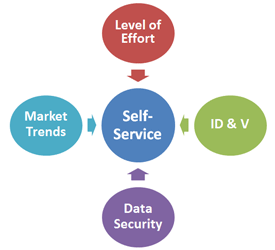 In all likelihood, you offer at least one self-service channel, even if it is as basic as an IVR. So why are you still talking to customers? It’s because self-service falls short, and customers can’t find information or complete transactions without assistance. The value in closing this gap is huge – in dollars and customer happiness.
In all likelihood, you offer at least one self-service channel, even if it is as basic as an IVR. So why are you still talking to customers? It’s because self-service falls short, and customers can’t find information or complete transactions without assistance. The value in closing this gap is huge – in dollars and customer happiness.
Customers Evaluate the Level of Effort
Matt Dixon surveyed 125,000 consumers for his book, The Effortless Experience, and reports that customers do not necessarily want to call. They call because they can’t figure it out on their own. When calling is the option to which customers resort, it reveals a problem to solve.
To increase the desire – and ability – to self-serve, your options must be designed effectively, require low effort, and be intuitive, with no learning curve. Moreover, customers should have access to the same information that your agents do. It increases their opportunity to self-serve and smooths the transition to assisted service, when necessary.
In addition, don’t overwhelm your customers with channel options just because you can. Make logical channel choices for information and transactions.
Expanding Self-Service Requires Expanding ID&V
To support more complex transaaction, you must be able to identify and verify customers who wish to self-serve.
We are all used to entering account-based data in response to an IVR prompt. Yet risk management professionals call for eliminating use of SSNs and account numbers printed on mailings. Voice biometrics represents a potential solution, but this technology is not getting traction in most verticals. Identification and authentication for web portals and mobile apps also command elevated attention as as well as secure email, chat, and SMS (text).
Changes in mainstream technology and increasing security on mobile devices will help advance authentication as we all move from pins and passwords to fingerprints and other biometrics.
Hit the Sweet Spot for Data Control and Security
Proper identification and verification can help build customer confidence in self-service channels, but data control and security concerns can stop companies (and customers) from trying new self-service features. Mobile devices offer a benefit in that it is harder for someone to intercept data sent to/from these devices than it is on a public network. Security is enhanced on any device when it incorporates spyware or some other form of malicious software prevention.
Acknowledge data security concerns when deciding which services to provide over each channel and inform your customers how and why you protect their data.
Monitor Market Innovation
When an innovation in service channels requires us to learn something new or update our approach to personal devices, we tend to view it as “high level of effort” and likely avoid it. But as new technology gains mainstream acceptance, its use becomes second nature. In fact, it heightens our expectations on communicating with the companies with which we do business. For example, in today’s market, we expect companies to support mobile apps and texting. Voice biometrics, finger print, or visual authentication could begin to expand fairly quickly as mobile devices and apps use those forms of identification.
Word to the wise: Use advancements such as voice-assisted mobile apps or web virtual assistants when use-cases are compelling. Avoid deploying that latest “shiny object” merely as a gimmick. It’s less likely to yield an attractive ROI.
Move Forward
Self-service can have a huge, positive financial impact. As you move forward with your self-service strategy, evaluate options using the aforementioned criteria. And remember: To ensure an attractive payback, your customers have to use your self-service options. That requires self-service that is low effort, has credible identification and verification, has sufficient data control and security, and keeps up with market innovations.
